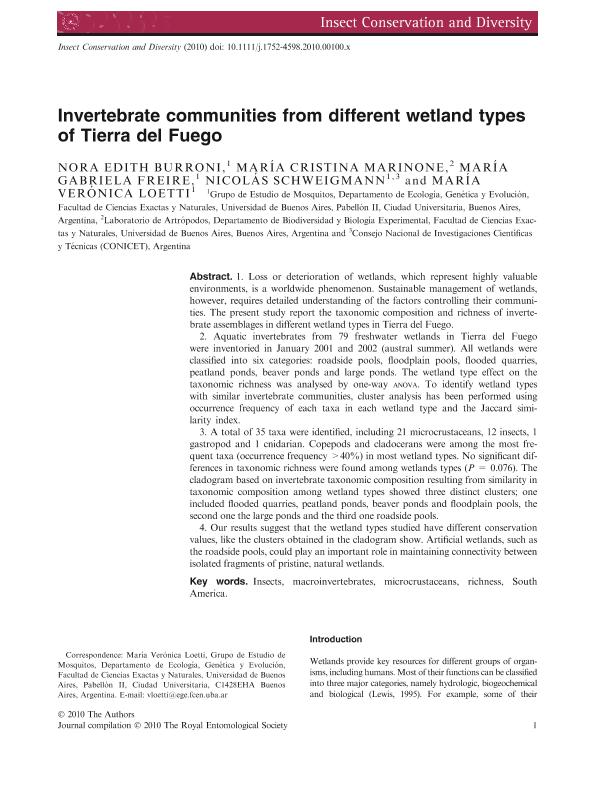Artículo
Invertebrate communities from different wetland types of Tierra del Fuego
Burroni, Nora Edith ; Marinone, María Cristina; Freire, María Gabriela; Schweigmann, Nicolas Joaquin
; Marinone, María Cristina; Freire, María Gabriela; Schweigmann, Nicolas Joaquin ; Loetti, María Verónica
; Loetti, María Verónica
 ; Marinone, María Cristina; Freire, María Gabriela; Schweigmann, Nicolas Joaquin
; Marinone, María Cristina; Freire, María Gabriela; Schweigmann, Nicolas Joaquin ; Loetti, María Verónica
; Loetti, María Verónica
Fecha de publicación:
02/2011
Editorial:
Wiley-liss, Div John Wiley & Sons Inc
Revista:
Insect Conservation And Diversity
ISSN:
1752-458X
Idioma:
Inglés
Tipo de recurso:
Artículo publicado
Clasificación temática:
Resumen
1. Loss or deterioration of wetlands, which represent highly valuable environments, is a worldwide phenomenon. Sustainable management of wetlands, however, requires detailed understanding of the factors controlling their communities. The present study report the taxonomic composition and richness of invertebrate assemblages in different wetland types in Tierra del Fuego.2. Aquatic invertebrates from 79 freshwater wetlands in Tierra del Fuego were inventoried in January 2001 and 2002 (austral summer). All wetlands were classified into six categories: roadside pools, floodplain pools, flooded quarries, peatland ponds, beaver ponds and large ponds. The wetland type effect on the taxonomic richness was analysed by one-way anova. To identify wetland types with similar invertebrate communities, cluster analysis has been performed using occurrence frequency of each taxa in each wetland type and the Jaccard similarity index.3. A total of 35 taxa were identified, including 21 microcrustaceans, 12 insects, 1 gastropod and 1 cnidarian. Copepods and cladocerans were among the most frequent taxa (occurrence frequency >40%) in most wetland types. No significant differences in taxonomic richness were found among wetlands types (P = 0.076). The cladogram based on invertebrate taxonomic composition resulting from similarity in taxonomic composition among wetland types showed three distinct clusters; one included flooded quarries, peatland ponds, beaver ponds and floodplain pools, the second one the large ponds and the third one roadside pools.4. Our results suggest that the wetland types studied have different conservation values, like the clusters obtained in the cladogram show. Artificial wetlands, such as the roadside pools, could play an important role in maintaining connectivity between isolated fragments of pristine, natural wetlands.
Palabras clave:
Insects
,
Macroinvertebrates
,
Microcrustaceans
,
Richness
,
South America
Archivos asociados
Licencia
Identificadores
Colecciones
Articulos(IEGEBA)
Articulos de INSTITUTO DE ECOLOGIA, GENETICA Y EVOLUCION DE BS. AS
Articulos de INSTITUTO DE ECOLOGIA, GENETICA Y EVOLUCION DE BS. AS
Citación
Burroni, Nora Edith; Marinone, María Cristina; Freire, María Gabriela; Schweigmann, Nicolas Joaquin; Loetti, María Verónica; Invertebrate communities from different wetland types of Tierra del Fuego; Wiley-liss, Div John Wiley & Sons Inc; Insect Conservation And Diversity; 4; 1; 2-2011; 39-45
Compartir
Altmétricas



